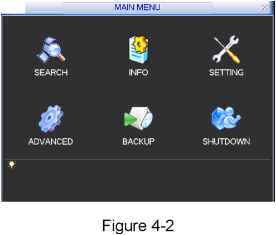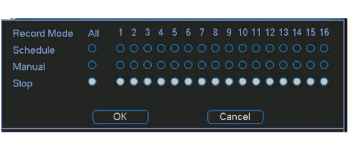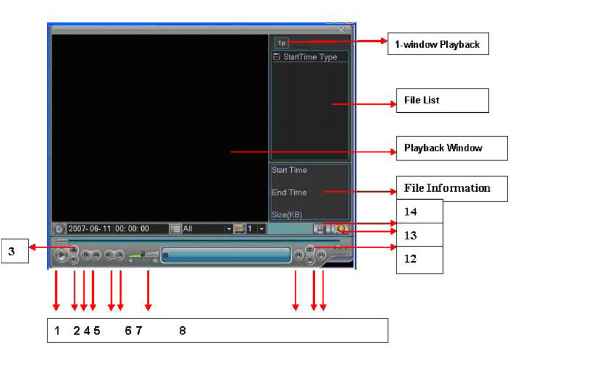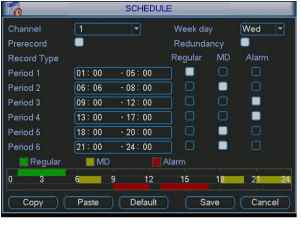
8(903)201-21-74
ООО "ЧетыреДатчика"
 |
Оператор: 8(903)201-21-74 ООО "ЧетыреДатчика" |
|
Оператор: 8(903)201-21-74 ООО "ЧетыреДатчика" |
Главная страница Dvr following and features 1 2 3 4 5 6 ... 12 4 Overview of Navigation and Controls Before operation, please make sure you have properly installed HDDs and all the cable connections. 4.1 Login, Logout & Main Menu 4.1.1 Login When the system boots up, default video display is in multiple-window mode. Click Enter or left click mouse, you can see the login interface. See Figure 4-1. System consists of four accounts: Username: admin. Password: admin. (administrator, local and network) Username: 888888. Password: 888888. (administrator, local only) Username: 666666. Passwords: 666666(Lower authority user who can only monitor, playback, backup and etc.) Username: default. Password: default(hidden user) For your system security, please modify you password after first login. You can use USB mouse, front panel, remote controller or keyboard to input. About input method: Clickil23jto switch between numeral, English character (small/capitalized) and denotation. Note: 3 times login failure within 30 minutes will result in account lock! SYSTEM LOGIN User Name Password Figure 4-1 4.1.2 Main Menu When you login, the system main menu is shown as below. See Figure 4-2. There are total six icons: search, information, setting, backup, advanced and shutdown. Move the cursor to highlight the icon, then double click mouse to enter the sub-menu.  4.1.3 Logout There are two ways for you to log out. One is from menu option: In the main menu, click shutdown button, you can see an interface is shown as below. See Figure 4-3. SHUTDOWN  Logout mi Password is t after logout. Figure 4-3 There are several options for you. See Figure 4-4. Logout menu user Restart application Shutdown Restart system Switch user Figure 4-4 The other way is to press power button on the front panel for at least 3 seconds, system will stop all operations. Then you can click the power button in the rear panel to turn off the DVR. 4.1.4 Auto Resume after Power Failure The system can automatically backup video and resume previous working status after power failure. 4.1.5 Replace Button Battery Please make sure to use the same battery model if possible. We recommend replace battery regularly (such as one-year) to guarantee system time accuracy. 4.2 Recording Operation 4.2.1 Live Viewing When you login, the system is in live viewing mode. You can see system date, time and channel name. If you want to change system date and time, you can refer to general settings (Main Menu->Setting->General). If you want to change the channel name, please refer to the display settings (Main Menu->Setting->Display)
Note: Please refer to the following sheet for channel status. s stands for opening switch function, Ш stands for closing switch function. 4.2.2 Manual record Note: You need to have proper rights to implement the following operations. Please make sure the HDDs have been properly installed. 4.2.2.1 Manual record menu There are two ways for you to go to manual record menu. Right click mouse or in the main menu, Advanced->Manual Record. In live viewing mode, click record button in the front panel or record button in the remote control. Manual record menu is shown as in Figure 4-5. 4.2.2.2 Basic operation There are three statuses: schedule/manual/stop. Highlight icon o to select corresponding channel. Manual: the highest priority. After manual setup, all selected channels will begin ordinary recording. Schedule: channel records as you have set in recording setup (Main Menu- >Setting->Schedule) Stop: all channels stop recording. MANUAL RECORD: Record Mode All Schedule О Manual Q, 1 2 3 4 5 6 9 10 11 12 13 14 15 16 О О О О 0000000*00000000 00000000000*0 О Cancel Figure 4-5 4.2.2.3 Enable/disable record Please check current channel status: o means it is not in recording status, means it is in recording status. You can use mouse or direction key to highlight channel number. See Figure 4-6. MANUAL RECORD Record Mode All 1 2 3 4 5 7 8 9 10 11 12 13 14 15 16 О ОООООООФОООООООО О О О О О О О О О О О О О О Figure 4-6 4.2.2.4 Enable all channel recording Highlight o below All, you can enable all channel recording. All channel schedule record Please highlight ALL after Schedule . See Figure 4-7. When system is in schedule recording, all channels will records as you have previously set (Main menu->Setting->Schedule). The corresponding indication light in front panel will turn on. ~--- MANUAL RECORDJ Record Mode All Schedule Manual Stop All 1 2 3 4 5 6 7 8 9 10 11 12 13 14 15 16 * О oooooooooooooooo о о о о о о о о о о о о 0 q о о q Cancel Figure 4-7 All channel manual record Please highlight ALL after Manual. See Figure 4-8. When system is in manual recording, all scheduled set up you have set in will be null ((Main menu->Setting->Schedule)). You can see indication light in front panel turns on, system begins manual record now. MANUAL RECORD Record Mode Schedule Manual Stop All 1 2 3 4 5 6 7 8 9 10 11 12 13 14 15 16 О OOOOOOOOOOOOOOOO
о oooooooooooooooo Figure 4-8 4.2.2.5 Stop all channel recording Please highlight ALL after Stop . See Figure 4-9. System stops all channel recording no matter what mode you have set in the menu (Main menu->Setting->Schedule) (Ш manuatrecord xl  4.3 Search & Playback 4.3.1 Search Menu There are two ways for you to go to search menu. Click Pause/Play button in the remote control. Click search in the main menu. Search interface is shown as below. See Figure 4-10. Usually there are three file types: R: regular recording file. A: external alarm recording file. M: motion detection recording file C: card and pos test overlay recording file(For some special series only) There are several playback windows. This System supports 1-ch playback.  Figure 4-10 Please refer to the following sheet for more information.
4.3.2 Basic Operation 4.3.2.1 Playback There are various search modes: video type, channel number or time. The system can max display 128 files in one screen. You can use up/down button to turn page. Select the file name and double click mouse (or click enter button), you can view file content. 4.3.2.2 Accurate playback Input time (h/m/s) in the time column and then click playback button, system can operate accurate playback. 4.3.2.3 Synchronized playback function when playback During playback process, click numeral key, system can switch to the corresponding channel video of the same time. 4.3.2.4 Digital zoom When the system is in full-screen playback mode, drag your mouse in the screen to select a section and then left click mouse to realize digital zoom. You can right click mouse to exit. 4.3.2.5 File backup System supports backup operation during search. You can draw a V before file name (multiple choices). Then click backup button (Button 14 in Figure 4-10). 4.3.2.6 Slow playback and fast playback Please refer to the following sheet for slow play and fast playback function.
4.3.2.7 Fast forward/fast backward and frame by frame playback Illustration Special Functions of Shuttle and Jog Remarks
In forward or backward mode, double click Pause/Play button to get normal playback. Frame rate may vary due to different version. 4.3.2.8 Backward playback and frame by frame playback
Remarks When system is in backward play or frame by frame playback mode, you can click play button to go to normal playback. Note: All the operations here (such as playback speed, channel, time and progress) have relationship with hardware version. Some series DVRs do not support some functions or playback speeds. 4.3.3 Calendar Click calendar iconiJ in Figure 4-10, system pops up calendar for your reference. Highlighted date means that there are record files in that day. You can click blue date to view file list. In Figure 4-11, there are video files in March 13th and 14th. Double click date to view file list. Sun Mon Tue Wed Thu Fri Sat [31][31][Ж]ИШП-5 !П-б1 гтпгшпгтдпг1!ПШ1г-22 и 23j Figure 4-11 4.4 Record Setup (Schedule) When the system boots up, it is in default 24-hour regular mode. You can set record type and time in schedule interface. 4.4.1 Schedule Menu In the main menu, from setting to schedule, you can go to schedule menu. See Figure 4-12. There are three record types: R-Regular, MD-Motion detection, A- Alarm. In some series, system also supports C-Card)  Figure 4-12 4.4.2 Basic Operation There are totally six periods. See Figure 4-12. Channel: Please select the channel number first. You can select all if you want to set for the whole channels. Week day: There are eight options: ranges from Saturday to Sunday and all. Redundancy: System supports redundancy backup function. You can highlight Redundancy button to activate this function. Please note, before enable this function, please set at least one HDD as redundant. Refer to the manual for detailed information. Prerecord: System supports prerecord function. The previous one to three seconds video before alarm occurs can be included in recorded video. Record types: There are three types: regular, motion detection (MD) and Alarm. Please highlight icon Я to select the corresponding function. After all the setups please click save button, system goes back to the previous menu. At the bottom of the menu, there is a color bar for your reference. Green stands for regular recording, yellow stands for motion detection and red stands for alarm recording. 4.4.1.1 Quick Setup This function allows you to copy one channel setup to another. After setting in channel 1, you can click paste button and turn to channel 2 and then click copy button. You can finish setting for one channel and then click save button or you can finish all setup and then click save button to memorize all the settings. 4.4.1.2 Redundancy Redundancy function allows you to memorize record file in several disks. These files are created, packaged and closed simultaneously. When there is file damage occurred in one disk, there is a spare one in the other disk. You can use this function to maintain data reliability and safety. In the main menu, from Setting to Schedule, you can highlight redundancy button to enable this function. See Figure 4-12. In the main menu, from Advanced to HDD management, you can set one or more disk(s) as redundant. You can select from the dropdown list. See Figure 4-13. System auto overwrites old files once hard disk is full. Please note only read/write disk or read-only disk can backup file and support file search function, so you need to set at least one read-write disk otherwise you can not record video. Note: About redundancy setup please note: If current channel is not recording, current setup gets activated when the channel begin recording the next time. If current channel is recording now, current setup will get activated right away, the current file will be packet and form a file, then system begins recording as you have just set. After all the setups please click save button, system goes back to the previous menu. HDD MANAGEMENT HDD No. 2 3 4 ООО О. Type Read/Write Status Normal Capacity 79.99 GB Record time 00-00-00 00:00:00/00-0 Alarm Set ] Alarm Release 1 Setto ReadWrite - ReadA/Vrite Read only Redundant Execute Format Figure 4-13 Playback or search in the redundant disk. There are two ways for you to playback or search in the redundant disk. Set redundant disk(s) as read-only disk or read-write disk (Main menu->Advanced->HDD management). See Figure 4-13.System needs to reboot to get setup activated. Now you can search or playback file in redundant disk. Dismantle the disk and play it in another PC. 4.5 Motion Detect 4.5.1 Go to Motion Detect Menu In the main menu, from Setting to Detect, you can see motion detect interface. See Figure 4-14. 4.5.2 Motion Detect Detection menu is shown as below. See Figure 4-14. Channel: select the channel you want to implement motion detection. Type: in the dropdown list, select motion detection item. Record channel: select the channel to activate recording function once alarm occurred. Please make sure you have set MD record in encode interface(Main Menu->Setting->Schedule) and schedule record in manual record interface(Main Menu->Advanced->Manual Record) Enable tour: Here is for you to activate tour between different cameras. Latch: when motion detection complete, system auto delays detecting for a specified time. The value ranges from 10-300(Unit: second) PTZ preset: Click set button, the interface is shown as in Figure 4-15.Here you can set preset for one or more channels. Region: click select button to set motion detection region. There are 396(PAL)/330(NTSC) small zones. See Figure 4-16. Sensitivity: there are six levels. The six-level is of the highest sensitivity. Alarm output: when alarm occurred, system enables peripheral alarm devices. Show message: System pops up message in the screen to alert you once alarm occurred. 1 2 3 4 5 6 ... 12 |